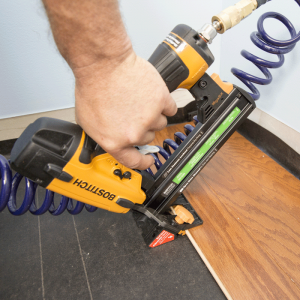You’ve just bought beautiful, brand new hardwood floors and are eager to get them installed. You’ve got your tools ready, but one question lingers in the back of your mind: Can I use a brad nailer for hardwood floors? It’s a common question, especially for DIY enthusiasts, as those little brad nailers seem like the perfect tool for a smooth and efficient installation.

Image: fencefrenzy.com
But before you dive into hammering those nails, let’s delve into the world of hardwood flooring installation and understand when a brad nailer is a good choice, and when it’s best left on the shelf. In this comprehensive guide, we’ll explore the ins and outs of hardwood floor installation, answer your question about brad nailers, and equip you with the knowledge to make the right decision for your project.
Understanding Hardwood Floor Installation
Hardwood flooring installation is a meticulous process that requires precision and careful attention to detail. It’s not just about hammering nails; it’s about creating a beautiful, durable, and long-lasting surface that adds value to your home. The choice of fastening method plays a crucial role in the success of your project.
There are several ways to install hardwood floors, each with its own advantages and disadvantages:
- Nail Down: The traditional method of attaching hardwood flooring directly to the subfloor using nails. This technique provides a solid and stable floor that is great for heavy traffic areas.
- Glue Down: Involves adhering flooring planks directly to the subfloor using a strong adhesive. Perfect for situations where nailing is not feasible, like over concrete.
- Floating: A system where planks interlock without being directly attached to the subfloor. Floating floors are popular due to their ease of installation and potential for sound reduction.
- Click-Lock: A modern installation method utilizing planks that click together, often floating on a layer of underlayment. This system offers speed and ease of installation.
The Case for Brad Nailers
Brad nailers are a popular tool for DIY projects, particularly for furniture and trim work. They are lightweight, easy to maneuver, and can drive small finish nails into wood without leaving large nail holes. But are they suitable for hardwood floors?
The answer is: it depends. Brad nailers can certainly be used for hardwood floors, but they are not always the best choice.
When Brad Nailers Might Work
- Thin Flooring: If you’re working with thinner flooring boards, such as those under ¼ inch thick, a brad nailer might be a suitable option. The smaller nails driven by these nailers have a lesser chance of splitting thin wood.
- Solid Subfloor: A solid subfloor is paramount for successful brad nailer use. The nail needs a firm anchor point to avoid creating gaps or causing buckling in the floor.
- Less Traffic Areas: If you are installing hardwood floors in a room with lower traffic, such as a bedroom or guest room, a brad nailer might be appropriate.

Image: bestproducthunter.com
When Brad Nailers Could Cause Problems
- Thick Flooring: For thicker hardwood flooring, such as those exceeding ¼ inch, a brad nailer might not provide sufficient holding power. The thin nails might not penetrate the floor and subfloor adequately, potentially leading to loose planks or squeaking.
- Unstable Subfloor: If your subfloor is uneven, old, or composed of materials that are not ideal for nailing, such as plywood with thin layers, avoid using a brad nailer.
- High Traffic Areas: Areas with high foot traffic (living rooms, hallways) demand strong anchoring. Thick nails driven into the subfloor provide superior hold and longevity in these areas.
The Power of a Flooring Nailer
For superior strength and stability, especially in high-traffic areas, a flooring nailer is highly recommended. Flooring nailers are designed specifically for hardwood flooring installation and are equipped with thicker nails and more power to drive those nails deep into the subfloor.
Flooring nailers come in various sizes and types, including:
- Pneumatic Flooring Nailers: These nailers rely on compressed air to drive nails and offer impressive power and speed.
- Cordless Flooring Nailers: These nailers use rechargeable batteries for a cleaner, more convenient option, especially for smaller projects.
Expert Tips for Hardwood Floor Installation
Here are some valuable tips from experienced flooring installers:
- Always Consult Manufacturer Instructions: Before starting your project, read the manufacturer’s instructions for your flooring and tools. These instructions provide crucial information regarding the proper installation methods and necessary tools.
- Subfloor Preparation is Key: Prior to installing hardwood, ensure your subfloor is level, solid, and free of any imperfections. Patching and sanding may be necessary to create a smooth surface for the flooring.
- Start at the Center: To ensure even spacing, begin nailing from the center of the room and work your way outward. This method helps avoid crooked planks or uneven edges.
Can I Use A Brad Nailer For Hardwood Floors
Conclusion
Whether you are a seasoned DIYer or a first-time home improver, choosing the right tools for hardwood floor installation is crucial. While a brad nailer can work for certain situations, choosing a dedicated flooring nailer for thicker flooring and high-traffic areas will ensure a beautiful and long-lasting hardwood floor installation.
Remember, careful planning, proper preparation, and the right tools are the keys to a successful, stress-free project. So, before you grab that brad nailer, carefully consider the type of flooring you are installing, the condition of your subfloor, and the level of traffic the floor will endure. With the right information and tools, you’re well on your way to creating a beautiful and durable hardwood floor that you can enjoy for years to come!






